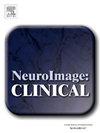重叠结构和功能连接中断在临床高危精神病参与者:网络分析研究
IF 3.4
2区 医学
Q2 NEUROIMAGING
引用次数: 0
摘要
精神分裂症涉及解剖和功能网络的异常连接。然而,目前尚不清楚这种中断是否存在于临床高危精神病(chrp)参与者中,以及结构和功能连接改变之间是否存在重叠。我们获得了110名chrp参与者和49名健康对照(HC)的扩散磁共振成像(dMRI)和静息状态磁共振成像(rsfMRI)数据。采用网络分析方法探索dMRI和rsfMRI连通性的差异以及两种模式之间的潜在重叠。此外,我们还研究了dMRI和rsfmri数据、临床和神经认知变量以及与临床结果的相关性。我们在CHR-Ps的dMRI和rsfmri数据中观察到枕叶、顶叶、颞叶和额叶皮质的高连接和低连接。此外,dMRI和rsfmri定义的重叠节点在cr - ps和HC之间存在差异,与视觉网络、右侧腹侧注意网络和右侧默认模式网络重叠。相关分析显示,chrp症状的严重程度、认知缺陷和dMRI/ rsfmri定义的低连通性和超连通性之间存在显著关系。最后,与非持续性精神病症状相比,具有持续性精神病症状(APS)的chrp个体具有异常的dMRI和rsfMRI连通性。我们的研究显示,在chrp参与者中,dMRI和rsfMRI连接出现了细微但广泛的中断。具体来说,我们确定了几个枕叶、顶叶、颞叶和额叶区域,其特征是与临床症状和认知障碍的严重程度相关的连接过度和连接不足。此外,我们的研究结果表明,dMRI和rsfMRI连通性测量可以作为chrr - ps临床结果的潜在生物标志物。本文章由计算机程序翻译,如有差异,请以英文原文为准。
Overlapping structural and functional connectivity disruptions in clinical high-risk for psychosis participants: A network analysis study
Schizophrenia involves aberrant connectivity of anatomical and functional networks. However, it is currently unclear whether such disruptions are present in clinical high-risk for psychosis (CHR-P) participants and whether there may be an overlap between structural and functional connectivity alterations.
We obtained diffusion magnetic resonance imaging (dMRI) and resting-state, magnetic resonance imaging (rsfMRI) data from N = 110 CHR-P participants and N = 49 healthy controls (HC). A network analysis approach was employed to explore differences in dMRI and rsfMRI connectivity as well as potential overlap between both modalities. In addition, correlations between dMRI and rsfMRI-data, clinical and neurocognitive variables as well as with clinical outcomes were investigated.
We observed hyper- and hypoconnectivity across occipital, parietal, temporal, and frontal cortices in both dMRI and rsfMRI-data in CHR-Ps. Moreover, dMRI- and rsfMRI-defined overlapping nodes that differed between CHR-Ps vs. HC overlapped with visual networks, right ventral attention network, and right default mode network. Correlational analyses indicated significant relationships between the severity of CHR-P symptoms, cognitive deficits, and dMRI/rsfMRI-defined hypo- and hyper-connectivity. Finally, CHR-P individuals with persistent attenuated psychotic symptoms (APS) were characterised by aberrant dMRI and rsfMRI connectivity compared to non-persistent APS.
Our study shows subtle but widespread disruptions in dMRI and rsfMRI connectivity in CHR-P participants. Specifically, we identified several occipital, parietal, temporal, and frontal regions that were characterised by hyper and hypoconnectivity which correlated with the severity of clinical symptoms and cognitive impairments. Moreover, our findings suggest that dMRI and rsfMRI connectivity measures could serve as a potential biomarker for clinical outcomes in CHR-Ps.
求助全文
通过发布文献求助,成功后即可免费获取论文全文。
去求助
来源期刊

Neuroimage-Clinical
NEUROIMAGING-
CiteScore
7.50
自引率
4.80%
发文量
368
审稿时长
52 days
期刊介绍:
NeuroImage: Clinical, a journal of diseases, disorders and syndromes involving the Nervous System, provides a vehicle for communicating important advances in the study of abnormal structure-function relationships of the human nervous system based on imaging.
The focus of NeuroImage: Clinical is on defining changes to the brain associated with primary neurologic and psychiatric diseases and disorders of the nervous system as well as behavioral syndromes and developmental conditions. The main criterion for judging papers is the extent of scientific advancement in the understanding of the pathophysiologic mechanisms of diseases and disorders, in identification of functional models that link clinical signs and symptoms with brain function and in the creation of image based tools applicable to a broad range of clinical needs including diagnosis, monitoring and tracking of illness, predicting therapeutic response and development of new treatments. Papers dealing with structure and function in animal models will also be considered if they reveal mechanisms that can be readily translated to human conditions.
 求助内容:
求助内容: 应助结果提醒方式:
应助结果提醒方式:


